>
2012 marks the 50th Anniversary of the American Studio Glass Movement, and its celebration will be marked with many events and exhibitions. The focus of the anniversary celebrations will mainly be on hot-glass and taking glass making from the factory to the artist’s studio, using the 1962 Toledo glass workshop as the birth date.

Toledo glass workshop in the spring of 1962
Horizontal/Vertical, 1974. Harvey Littleton. Chazen Museum of Art, Madison, Wisconsin
Early Fused Glass
While the precise origins of glass fusing techniques are not known with certainty, there is archeological evidence that the Egyptians were familiar with basic techniques. Some historians argue that the earliest fusing techniques were first developed by the Romans, who were much more prolific glassworkers. Fusing was the primary method of making small glass objects for approximately 2,000 years, until the development of the glass blowpipe largely replaced fusing due to its greater efficiency and utility.
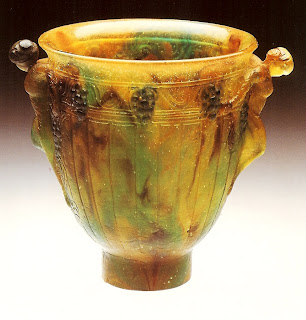
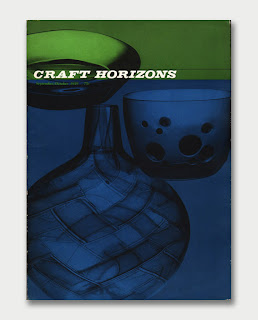



___________________________________________
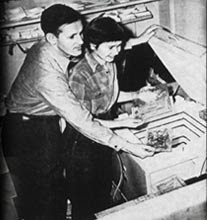

Michael and Francis Higgins’ were a husband-and-wife team who produced commercial tableware for Dearborn Glass.Both studied at the Chicago Institute of Design. The couple individually created unique hinged boxes, mobiles, flat panels and vessel forms that were distinguished by bold geometric patterns and innovative techniques that retain their freshness with their delicate designs.


___________________________________________

Archangel, 1956. Erdis Eckhardt
cast glass. Corning Museum of Glass

Uriel, 1968. Erdis Eckhardt
cast glass. Corning Museum of Glass


1944 Craft Horizons and 2012 American Craft Magazine
Early books about glass offered technical advice, a general history of glass, or the occasional survey of contemporary work. Information about glass was available only in industrial manuals, amongst them “The Art of Glassmaking” (1947) by Sydney Waugh, a designer for Corning Glass. Waugh’s book included declarations that glass could only be made in large factories.
California artist Kay Kinney studied glazes and ceramics and later experimented with glass in the early 1960’s. Kinney’s book “Glass Craft: Designing, Forming, Decoration” (1962) was written long before the “fusing-compatible” era. Her book has information about mold-making, fusing and slumping projects utilizing window glass, bottles, and other types of glass.

Kinney’s book was written for glass novices, with simple, straightforward instructions on cutting and fusing.
Click HERE to jump to Part 2 Exploring Technique and Content – the ’60’s, ’70’s & ’80’s
Washington, DC and Sunderland, UK Sign Friendship Agreement
>
The UK’s Sunderland City Council will be signing a “Friendship Agreement” with Washington, DC tomorrow, February 22, 2010. Sunderland is the only non-capital in the world to have such an agreement with Washington, DC. The original agreement was signed in 2006, and a formal renewal and signing will take place at the British Embassy with the UK’s deputy head of mission to the US Philip Barton.In DC, delegates from Sunderland University, the Sunderland Chamber of Commerce and business representatives are joining Sunderland council chief executive Dave Smith at the Embassy renewal.
Delegates from the University of Sunderland tour the Washington Glass School
L-R Peter Fidler, Vice Chancellor Sunderland University, Angela Fidler, Erwin Timmers, WGS.
The delegation is attending a series of meetings, including a meeting with DC’s Mayor Gray – and a visit to the Washington Glass School.
Commercial Director of Sunderland AFC Gary Hutchinson said: “We all know that our city and region have strong links with the US and Washington DC. It was a major coup to see these strengthened in 2006, we’ve built upon that agreement and now we are about to renew it.”
Council leader Paul Watson said: “Since signing this historic Friendship Agreement with Washington DC, we’ve seen a range of economic and educational benefits.
“Young people in a number of our schools, as well as Sunderland Youth Parliament, have had the opportunity to learn more about America, explore issues important to young people on both sides of the Atlantic, as well as learn more about their own history and heritage.
In June 2006, Sunderland signed the original Friendship Agreement with Washington DC. The Friendship Agreement cements the city’s unique historical link with Washington DC, as George Washington’s ancestral home is located within Sunderland, England’s boundary and sets out to create benefits for the people of both cities through economic, educational, and cultural co-operation as well as exchanges of experience in key policy areas.
Later this year, Washington Glass School’s Professor Tim Tate and Professor Michael Janis will be teaching at the University of Sunderland and the UK’s National Glass Centre as part of their Fulbright Scholarship, and continues the interaction between the two glass centers.
♪ Happy Birthday, Mr President ♫
>
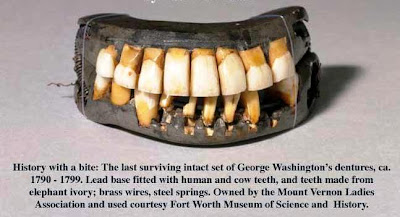
George Washington’s dentures
George Washington FUN FACTS
–Admiring biographers make much of the fact that
–When the capital was moved from
–One of the most seriously misleading of the
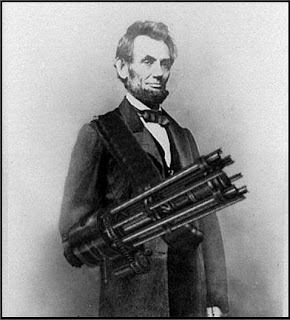
In 1842, Abe was challenged to a duel. Abe won.
Abraham Lincoln FUN FACTS
—
–In 1842,
–The clutter in
–Frederick Douglass, the celebrated black abolitionist and former slave, was invited by
–Once, shortly before his election to the Presidency,
Presidential trivia facts from: www.trivia-library.com
Bert Weiss Master Painting on Glass Class
>
Bert Weiss mixes his secret ingredient (7-Up) with his enamels. It is crisp and clean – and no caffeine.
Bert outlines the mixing process.
The class firings are reviewed in the morning.
Fuller Craft Museum Welcomes New Director Jonathan Fairbanks
>
The Board of Directors of Fuller Craft Museum has announce that Jonathan Leo Fairbanks has been named Fuller Craft’s new Director. Founder and Curator Emeritus of the Department of American Decorative Arts and Sculpture at the Museum of Fine Arts, Boston, Fairbanks has had a long-standing relationship with the Massachusetts-based contemporary craft museum. In fact, he was honored recently by Fuller Craft (along with Sam Maloof in 2009) with a Luminaries award for his lifelong dedication to the arts. Fairbanks now joins New England’s only museum dedicated to exhibitions that explore life through the art of contemporary craft.
 |
|
Jonathan Fairbanks, Director |
“We are so pleased to gain the leadership of such a distinguished museum veteran and artist,” said Chris Rifkin, Chairman of the Board. “This is an exciting time for Fuller Craft. Jonathan has a profound understanding of the connectedness of craft to the artist, and to all of us in our everyday lives. This makes him the right person to lead our talented staff and make our museum a focal point, a mirror to what’s happening in the studio craft world. His vision, experience, and national reputation as one of the country’s foremost experts in craft will be tremendously beneficial to our museum.”
Fairbanks, who has been working with museums for more than 50 years, is considered to be one of the nation’s top authorities in arts and antiques. As a Curator of American Decorative Arts and Sculpture at the MFA, Boston from 1970 – 1999, he added significant contemporary craft collections to the museum, including works by 50 contemporary studio furniture makers, plus hundreds of ceramic, glass, and mixed media artists.
“The new studio crafts movement is the most exciting thing going on in American art today. People relate to craft, the authentic creations of the hand, brain, and heart,” said Fairbanks. “I have had the pleasure of knowing Fuller Craft since the early 1970s and believe that this nimble, soulful organization has a special opportunity to shine a spotlight on the important values of craft and shaping materials. Boston was the first large urban area in America with a great arts and crafts organization. Fuller Craft Museum built upon that tradition, and today is one of a handful of museums in the country dedicated entirely to showcasing fine contemporary craft. I am honored to be a part of the future of Fuller Craft Museum.“
Recycled Glass: Sculpture and Design
>
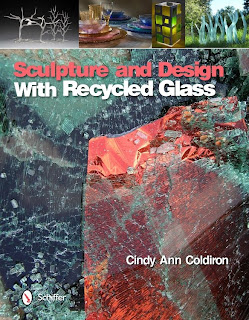
There are some great works and images of projects, including works by DC area artists Nikki O’Neill, Bill Hess and Cindy Ann Coldiron.

“Glass on Stone”
Erwin Timmers, 120″ x 20″ x 2″, kiln cast recycled window glass
photo by Anything Photographic
Our Erwin Timmers‘ environmental themed artwork has an attractive spread in the book. Erwin’s work has been in a number of art book publications this past year – his work has become increasingly popular. Erwin will be showing at Cincinatti’s Brazee Street Gallery in March.
Australian artists that work in recycled glass are also featured in the book – including some spectacular projects by Mark Wotherspoon. Mark reclaims glass from television tubes and creates evocative figures from the hard glass.
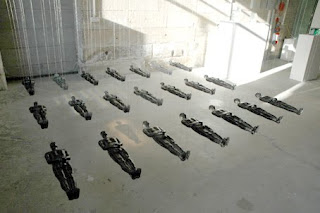
“Revelation of Death”
Mark Wotherspoon, 6′ x 8′ x 8′, kiln-cast television screen glass
Have a look at this fascinating look at artists that are looking to create environmentally sustainable artwork.
Who Loves You, Baby? Feel the Love.
>

Smackdown! Lionell VS Rick VS Kojack
The Process – Erwin Timmers Cast Glass Bottles
>
From This:
As part of the ongoing series titled ” The Process” that documents the methodology of an artist or technique – the work of Erwin Timmers is the feature of today’s pictorial.
Eco-artist Erwin Timmers creates artwork with environmental themes, and he works with materials that are diverted from the waste stream. As he prepares for the upcoming Smithsonian Craft Show, he invited us to have a look at how he starts the casting process as he creates his beautiful glass sculptures.
Working within his concepts of sustainable design and art, Erwin sourced glass from the US Probate Courthouse, in Greenbelt, MD for his artwork that was slated to end up in the trash dump.
Using plastic bottles cleared from the Anacostia River watershed (of which there was plenty to choose from), Erwin coats the bottles with a plaster/silica coating.
Using plastic bottles cleared from the Anacostia River watershed (of which there was plenty to choose from), Erwin coats the bottles with a plaster/silica coating.
Erwin extracts the remains of the plastic bottles from the molds.
Erwin then takes the cleaned molds and sets them in a bed of sand inside the glass kiln.
Erwin loads the cleaned glass into the reservoirs and sets the kiln.
After the firing, the glass is divested from the plaster and polished.
I Heart American Craft Council
>
Love is in the air
In time for Valentines, the Feb/March 2012 issue of American Craft magazine (published by the American Craft Council) features Washington Glass School Director Michael Janis answering the romantic question: “Who’s Your Platonic Craft Crush”. The new issue also has some great articles about Harvey Littleton and the Studio Glass Movement, and an article about ceramic sculptor Cristina Córdova.
For some reason tho, Michael is made to be yellow. Very yellow. I am (overly) Curious Yellow.
Michael Janis looking either very jaundiced or he’s Bart Simpson’s twin, Hugo.
And just who is Michael Craft Crushing on? Its no secret that it is glass & ceramic artist Christina Bothwell.
Flameworker Simone Crestani
>
Them!

The glass will ultimately be filled with neon and charged.
The glass bug anneals at the glass school – shown here sleeping on a nice soft bed of fiberfrax blanket.
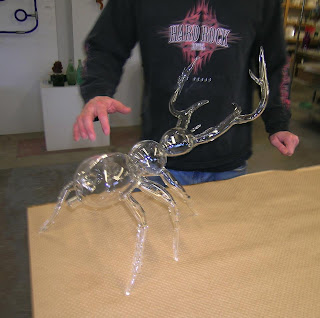
Things are all great – until the bug gets all aggressive and charges Rob. Oh, the humanity!






